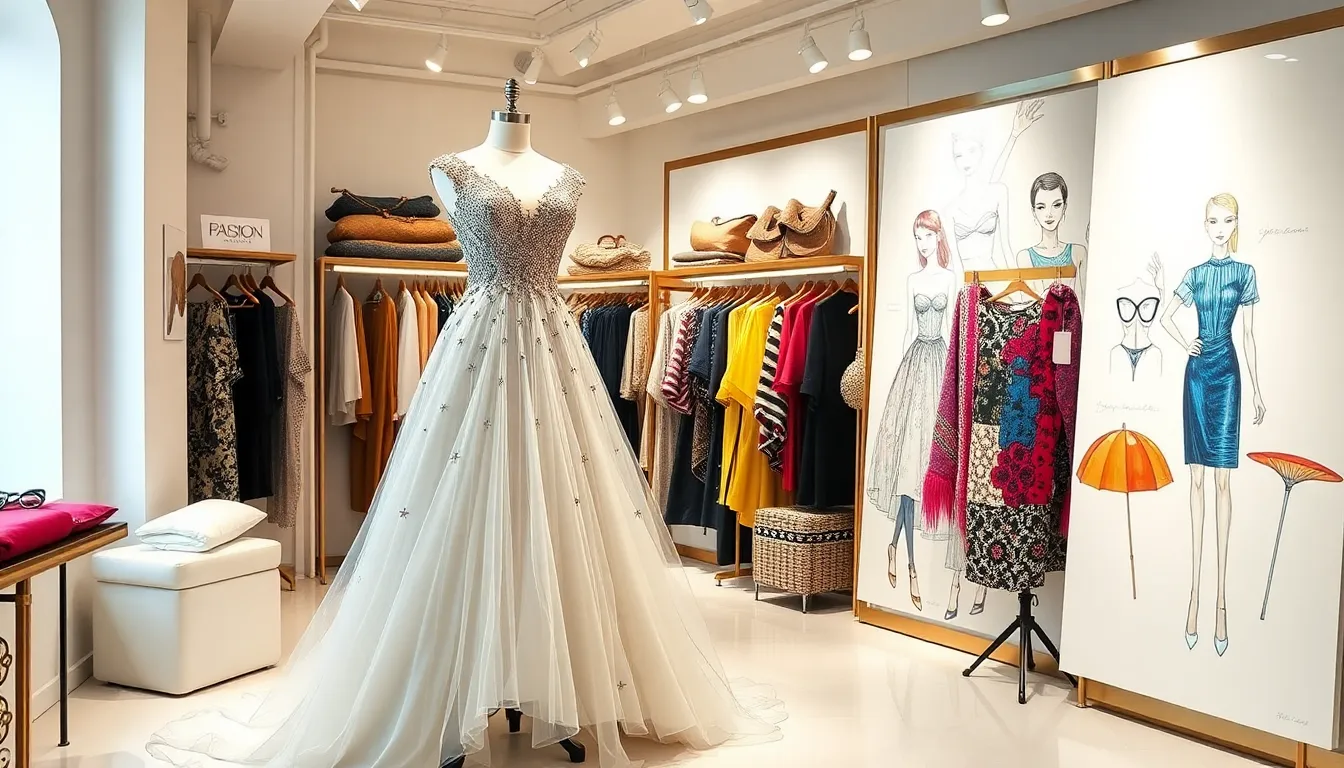Haute couture isn’t just a fancy French term that rolls off the tongue like a fine wine; it’s the pinnacle of fashion that makes even the most stylish among us weak at the knees. Imagine garments so exquisite they could make a potato sack look like a runway masterpiece. But what does haute couture really mean?
At its core, haute couture represents the artistry and craftsmanship behind custom-fitted clothing that’s made with the finest materials. Think of it as the VIP club of fashion where only the most exclusive designs get a golden ticket. So grab your front-row seat, because diving into the world of haute couture is like unwrapping a beautifully wrapped gift—each layer reveals a new level of luxury and creativity that’ll leave anyone breathless.
What Does Haute Couture Mean
Haute couture represents the epitome of fashion design, showcasing bespoke creations made with utmost precision and high-quality materials. Its exclusivity elevates it to a luxurious standard, captivating those who appreciate the artistry involved.
Historical Background
The origins of haute couture trace back to the mid-19th century. Charles Frederick Worth, an English designer in Paris, pioneered this concept by creating unique garments tailored for individual clients. The establishment of the Chambre Syndicale de la Haute Couture in 1868 further defined standards for this elite fashion sector. Regulation ensured that only authenticated designers could officially use the term “haute couture,” solidifying its prestige within the fashion landscape.
Key Characteristics
Exclusivity defines haute couture, as each piece is custom-made for a specific client. High artistry characterizes this fashion segment, emphasizing creative designs and meticulous craftsmanship. Materials used in haute couture often include luxurious fabrics like silk, brocade, and lace, which enhance the visual impact of each creation. Intricate detailing remains a hallmark, with hand-embroidered elements and specialized techniques employed in the process.
The Importance of Haute Couture

Haute couture holds significant value in the fashion landscape. Unique designs set trends that ripple through various segments of the industry.
Influence on Fashion Industry
Influencing the fashion industry, haute couture serves as a creative powerhouse. Designers often draw inspiration from haute couture’s innovative techniques and designs. Major fashion houses look to couture collections for emerging trends, shaping ready-to-wear releases. Couture garments highlight craftsmanship and artistic expression, pushing standard boundaries within fashion creation. The aura surrounding haute couture elevates its importance, attracting media attention and generating enthusiasm among fashion enthusiasts. Ultimately, haute couture inspires designers, connecting them to the broader fashion narrative.
Economic Impact
Haute couture contributes significantly to the fashion economy. The sector generates revenue not only from garment sales but also from related industries such as textiles and luxury goods. Exclusive fashion shows attract affluent clientele, stimulating tourism in fashion hubs like Paris. Additionally, the craftsmanship involved often necessitates skilled labor, supporting artisans and craftspeople. The prestige associated with haute couture enhances brand value, creating long-term loyalty and investment opportunities. Ultimately, haute couture influences market trends while bolstering the economic framework of the broader fashion industry.
Haute Couture vs. Ready-to-Wear
Haute couture and ready-to-wear represent two distinct segments of the fashion industry, each with unique characteristics and purposes.
Differences in Production
Production methods differ significantly between haute couture and ready-to-wear. Haute couture garments are handcrafted, tailored to fit individual clients. High-quality fabrics like silk and lace contribute to their exclusivity. In contrast, ready-to-wear items are mass-produced, creating standardized sizes and designs accessible to a larger audience. While haute couture focuses on artistry and custom details, ready-to-wear prioritizes efficiency and affordability.
Target Audience
Target audiences for haute couture and ready-to-wear vary considerably. Haute couture primarily caters to affluent clients seeking exclusive and personalized pieces. These individuals often attend high-profile events, requiring garments that showcase luxury and status. Ready-to-wear, on the other hand, targets a broader market, appealing to fashion-conscious consumers looking for stylish yet accessible options. Demographics include various age groups and income levels, making ready-to-wear a staple in everyday fashion.
Prominent Haute Couture Designers
Haute couture showcases a blend of artistry and exclusivity through its influential designers. They set trends that resonate throughout the fashion industry.
Notable Fashion Houses
Chanel stands out with its timeless elegance and innovative designs under the leadership of Coco Chanel. Dior, established by Christian Dior, revolutionized women’s silhouettes with the iconic “New Look.” Valentino captivates with romantic fabrics and intricate embroidery, while Givenchy leaves a mark through its classic yet modern creations. Jean Paul Gaultier is known for pushing boundaries, and its avant-garde style captures attention on runways worldwide.
Emerging Designers
Several emerging designers are gaining recognition in the haute couture realm. Andrea Johnston combines modern techniques with traditional craftsmanship, infusing fresh perspectives into classic designs. Nour Heshmat draws inspiration from diverse cultures, creating unique pieces with storytelling elements. Another rising star, Yiqing Yin, is celebrated for fluid silhouettes and innovative fabrications, showcasing outstanding creativity. Each of these designers enhances the haute couture landscape, bringing new ideas and energy to this elite fashion segment.
Conclusion
Haute couture stands as a testament to the artistry and luxury of fashion. It’s not just about clothing; it’s an experience that showcases the highest level of craftsmanship and creativity. Each piece tells a story of meticulous attention to detail and personal expression, making it a coveted treasure in the fashion world.
As haute couture continues to inspire and set trends, it remains a vital force in shaping the broader fashion landscape. The blend of tradition and innovation keeps this elite sector vibrant and relevant, captivating both clients and designers alike. Embracing haute couture means appreciating the extraordinary journey of fashion at its finest.




